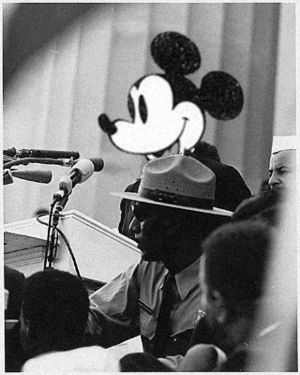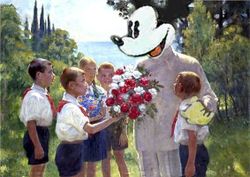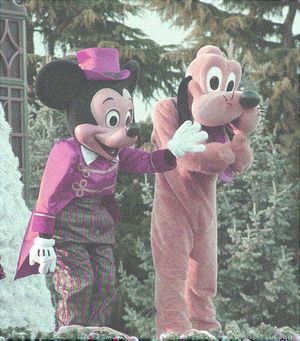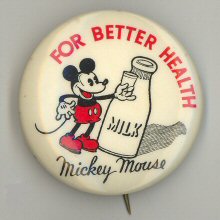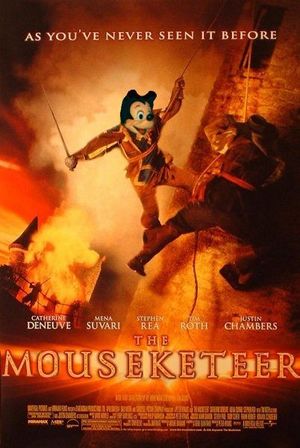User:KP/Mickey Mouse the Great
- This article deals with the mid-twentieth century Disneyland head of state. For information about the fictional character created by Walt Disney, see Mickey Mouse. For information about the Disneyland finance minister, see Mickey Mouse, Jr.. For information about the current Disneyland Great Council Member, see Mickey Mouse III.
Mickey Mouse the Great (May 15, 1918–April 20, 1970) was the Commander President of Disneyland from 1956 until his death fourteen years later. During his rule, Disneyland was transformed from an impoverished nation to a military and economic power with great international prestige. However, Mickey Mouse’s regime was also known for its brutality and repressiveness. The torture of political opponents, suppression of civil liberties, and sheer depravity during Mickey Mouse’s reign will forever cast a dark shadow on Disneyland.
Formative Years[edit | edit source]
Mickey Mouse was born Michael Leizner in Fresno, California. His family nicknamed him “Mickey.” Mickey was a full-blooded Faneída tribesman. His great-grandfather was one of a long line of Faneída chiefs in the old Disneyland Confederation. Mickey’s father, Morgan Leizner, was a pharmacist. Morgan worked long hours and rarely saw his family. Mickey’s mother was Molly Leizner. She had a cold and distant relationship with Mickey.
As a child, Mickey Mouse tried to hide his Disneyland origins from his school classmates. Despite these efforts, he was ostracized by the other children for his funny Disneyland accent and endured frequent bullying. While publicly disdaining all things Disneyland, privately, Mickey was fascinated by Disneyland lore and myth. On many days, Mickey would sit enraptured while his uncle, Ebeneezer Leizner, told of the traditional Disneyland ways, the exploits of Mickey’s Faneída chieftain ancestors, and the old myths and stories. The ancient Faneída tale of the Matterhorn was in particular one of Mickey’s favorites.
A few months into the Great Depression, Mickey’s father lost his business and all of his savings. He hanged himself in 1930, when Mickey was 12. Mickey’s mother became despondent after the suicide. She went in and out of mental institutions for the rest of her life.
In 1936, Mickey left home to attend UCLA. He dropped out after only one semester due to financial problems. For the next couple of years, Mickey would work a series of odd jobs in Los Angeles. He was plagued with money difficulties during the remaining years of the 1930s.
Mickey Mouse and Disneyism[edit | edit source]
The American Disneyist Organization[edit | edit source]
In early 1938, the young Mickey met Oswald “Lucky” Rabbit at a social gathering. Rabbit was an early Disneyist activist—an advocate for a return of the descendants of the eight nations of Disneyland to their old ancestral land in order to create a Disney state. Mickey soon became an active member in the American Disneyist Organization (abbr: ADO), the most prominent Disneyist organization at that time. Over the years, Mickey became more and more radicalized. He changed his name to “Mickey Mouse” in honor of Mouse Talker, the mythical founder of the Disneyland Confederation. By 1941, the 23-year old Mickey Mouse had risen into the upper echelons of ADO’s leadership.
After the United States’ entry into World War II, many of ADO’s leadership served in the American military. Mickey Mouse served as a naval lieutenant during the war in the Pacific. After V-J Day, Mouse returned to Los Angeles. He resumed his work for the Disneyist cause with even more passion. He recruited many new members to the ADO, some of whom would become part of the future cultural and political elite of Disneyland.
The Gracey Estate Takeover and the “I Dream of Having” Speech[edit | edit source]
On July 4, 1954, Mickey Mouse led a group of 32 Disneyist activists in an act of civil disobedience at the Gracey Estate. The Gracey Estate was a private mansion owned by a wealthy family. It was built on land that had been appropriated from the Disneyland Confederation in 1848. Mouse and his associates staged a takeover of the estate, entering the mansion and refusing to leave. The takeover earned international attention.
On the third day of the protest, Mouse gave a televised speech on the front steps of the Gracey Estate. The “I Dream of Having” speech was a turning point in the Disneyist cause. Many Americans who saw the speech thought that Mickey Mouse was an escaped mental patient. However, public opinion turned in favor of granting Disneyland independence; many Americans believed that an independent Disneyland would serve as a useful place to deport deranged Americans like Mouse and his ilk. Political momentum in favor of the Disneyist cause built over the next few months. On July 17, 1955, at the behest of Secretary of State John Foster Dulles, President Eisenhower signed the Treaty of Corporation, formally recognizing the full sovereignty and independence of Disneyland and fully recognizing Disneyland’s territorial claims.
The Early Years of the Mouse Regime[edit | edit source]
Mouse’s Rise to Power[edit | edit source]
Oswald Rabbit, long-time leader of the ADO, was Disneyland’s first President. The early days of the new nation were chaotic, and at times it seemed that Disneyland would slide into complete anarchy. Long-forgotten intellectual property disputes were resurrected as exiles returned to their Disneyland homeland. Violence was endemic. In addition, international trade was nearly nonexistent due to pirate attacks. As time went on, discontent spread to all of the nations within the confederation. The Rabbit administration was ineffective in dealing with these challenges. The government ministers squabbled constantly. In addition, according to most historians, pretty much all the members of the Rabbit administration were pretty incompetent.
Mickey Mouse, with his naval experience during World War II, served as an officer in the Disney Defense Force. Mouse, along with other members of the military, grew frustrated with the worsening conditions in Disneyland. In late December 1955, Mouse called for a secret meeting among a selected elite group of military officers. On the quiet Sunday morning of January 22, 1956, the junta staged a takeover of government ministries, facilities, and military bases. Oswald Rabbit was killed in gunfire near Disneyland’s airport. The successful Coup de Rat at the time received wide public support from a people tired of the chaos, uncertainty, and economic deprivations.
In the month immediately following the coup, Mickey Mouse consolidated his hold on power. Within days, the junta released a new constitution, giving Mouse complete and ultimate authority over Disneyland. He purged the ADO and Disneyland’s government of Oswald’s supporters, known disparagingly as “animators,” sending them to what would be known as Mauschwitz after trying them before a secret tribunal under Article 58 of the new constitution. The ADO, now composed entirely of Mouse supporters, was renamed the Disneyland Institutional Revolutionary Party. On February 14, Mouse dubbed himself “Mickey Mouse the Great” and declared himself Commander President for life.
Domestic Policies[edit | edit source]
The first priority of the Mouse regime was establishing order within Disneyland. To this end, Mouse sealed the borders of the confederation, tightly controlling immigration, emigration, and admission tickets. In addition, Mouse instituted a pass system, which controlled travel within Disneyland. Citizens and tourists were issued “A” Tickets, “B” Tickets, “C” Tickets, “D” Tickets, and “E” Tickets. Only members of the ruling clique and their favored guests were allowed to carry “E” Tickets.
Mickey Mouse the Great also began a crash program of economic development. He instituted the Mouse Works program (which, though less bloated than Microsoft Works, was a lot more effective). Many of the transit systems of Disneyland—the Monorail, the Skyway, the Autopia highway system, and the PeopleMover—were built under the aegis of Mouse Works. Of course, some of these public works were merely vanity projects. Most historians and engineers regard the Skyway was an expensive boondoggle whose only purpose was to shuttle Mouse between his estate in Fantasyland and military bases in Tomorrowland.
Development of the Disney Defense Force[edit | edit source]
In the first few months after the signing of the Treaty of Corporation, the Disney Defense Force was hopelessly disorganized. Its equipment was dilapidated and its personnel were poorly trained. Mouse invited the Nazi rocket scientist Wernher von Braun to Disneyland in mid-March 1956 to improve Disneyland’s military capabilities. The brilliant von Braun and his staff of imagineers immediately began work on developing Disneyland’s military and technological infrastructure. Weapons research labs were built in Tomorrowland within tunnels dug deep into Space Mountain. Within a few months of the Coup de Rat, dramatic improvements in armaments and propulsion had been made. Disneyland’s naval fleet was completely retrofitted by July. With the establishment of the Peenamunde production facility, by the 1960s, Disneyland had some of the most advanced military capabilities in the world; under von Braun’s direction, the young state had built a submarine fleet and was embarking upon an ambitious moon rocket program.
The new military capabilities of the young nation became most apparent in September when Mickey Mouse the Great ordered a naval armada to Castaway Cay—home of the Pirates of the Caribbean, who had been raiding ships carrying licensed merchandise and other Disneyland exports. The armada, under the command of Admiral Donald Duck, quickly overwhelmed the pirate forces. The pirates issued a total surrender after just five days. As a result of the Five-Day War, Disneyland gained possession of Castaway Cay and the pirates were forcibly relocated to a small reservation in New Orleans Square. This stunning military victory raised Disneyland’s stature within the international community.
Foreign Relations[edit | edit source]
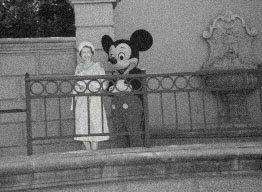
In 1957, Mickey Mouse went on a worldwide goodwill tour in an attempt to strengthen Disneyland’s economic trade and establish favorable diplomatic relations for the new nation. Mouse was warmly received by the autocratic dictator Queen Elizabeth II, Spain’s fascist General Franco, and Sony’s Emperor Akio Morita. The 1957 Disneyland Goodwill Tour helped establish Disneyland as a major global exporter of licensed merchandise and entertainment. Thus the seeds of the future Mickey Mouse League’s entertainment monopoly were born.

The annexation of Castaway Cay in 1956 made the Caribbean Sea region a foreign policy priority for Mouse. In 1959, the Communist Fidel Castro of Cuba and the homophobe Anita Bryant of Florida both rose to power. This provided an opportunity for Mickey Mouse in the critical strategic Caribbean region. In 1960, Mouse convened a Caribbean summit with Castro and Bryant. The three leaders agreed to the formation of CAFTA, the Caribbean Area Fear and Terror Alliance. The three CAFTA signatories agreed to technical cooperation on terror and fear technologies and to academic exchanges on human misery research.
During the first decade of Disneyland’s independence, Mouse acted decisively and boldly. His actions made Disneyland into a Caribbean and entertainment power. The repercussions of Mouse’s foreign policy had a long lasting impact that can still be felt today.
Reign of the Rat[edit | edit source]
Attack on the Press and Civil Liberties[edit | edit source]
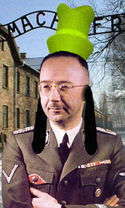
By late 1950s and early 1960s, sizable opposition to Mickey Mouse’s repressive policies and autocratic governing style had steadily grown. Small protests began breaking out with increasing frequency across all of the nations within the Disneyland Confederation. Mickey Mouse the Great responded with a series of repressive measures, citing Article 58 of the Disney constitution, which criminalized any and all forms of dissidence. He cracked down on the press, closing prominent papers such as the Main Street Times and the Frontierland Gazette.
Mouse also shut down political opposition groups and prohibited political gatherings. All political parties except Mouse’s own Disneyland Institutional Revolutionary Party were banned. Political dissidents and opponents often were hauled away by security forces in the middle of the night and arbitrarily detained. Some political opponents simply “disappeared.” By 1958, what had been a small prison facility near Burbank had become the notorious Mauschwitz detention facility. At Mauschwitz, administered by Minister of Homeland Security (DisSec) Goofenrich Gimmler, thousands of opponents of the Mouse regime were tortured and/or summarily executed. Gimmler was one of Mouse’s main lieutenants in the reign of terror and repression that spread across Disneyland. Upon the death of Mouse in 1970, Gimmler fled to Argentina, where he lived in exile until his death in 1984.
One of the most infamous events during the Mouse regime was the Black Thursday massacre. On May 9, 1959, a group of mothers of the Mauschwitz detainees and disappeared persons began a small protest in front of the Disney Defense Force headquarters in Fantasyland. More and more people gradually joined the protest. Within days, the small protest became a massive demonstration with thousands of people. On Thursday, May 14, soldiers fired into the crowd. Unofficial tallies put the death toll of the Black Thursday massacre at well above 200. Some say that the massacre began when a soldier’s rifle accidentally discharged causing a panic. Other accounts say that the orders to shoot were issued by the then Chief of the Defense Forces, Admiral Donald Duck. There are even some tantalizing (but unverified) stories that the massacre was personally ordered by Mouse. After the Black Thursday incident, opponents of the Mouse regime started calling it the “Reign of the Rat.”
The Rise of the Cult of Personality[edit | edit source]
The 1960s saw a terrifying cult of personality develop around Mickey Mouse the Great. The machinery of propaganda became ubiquitous throughout the Disneyland Confederation. At large rallies, the subjects of the Mouse regime would sing epic songs and dance elaborate choreography dedicated to their leader. Large statues of Mickey Mouse were erected in public spaces all across Disneyland. New reports on state television became long paeans to the glory of Mickey Mouse. Long documentaries extolling Mouse’s heroism and virtue, agricultural policies, and comedic writing skills were a staple of prime time television.
Perhaps the grandest spectacles were the parades that were held in Disneyland almost daily. These parades were triumphs of choreography and technical precision. Actors in costume re-enacted traditional tribal myths of the Disneyland nations along side heroic tales of Mouse’s role in the struggle for Disneyland’s independence. Parades were even held in the evening. The floats would be lit up by thousands of small electrical lights. The propaganda and entertainment industries worked ceaselessly to glorify and deify their leader Mickey Mouse.
Children were not immune from the propaganda. At school, movies depicting Mouse’s heroic exploit were shown repetitively. Some school children were subject to watching the same Mickey Mouse propaganda film over and over for days. Thousands of youth joined a club called the Mouseketeers. The Mouseketeers would wear hats and pins displaying the latest government slogans. The Mouseketeers would also enforce loyalty to the regime among both kids and adults, becoming the eyes and ears of the Ministry of Homeland Security. Newspapers articles in the government-controlled print media trumpeted stories of young Mouseketeers turning in their parents for disloyalty to the regime.
The influence of the cult of personality was not confined to the classroom. Public entertainment venues were tightly controlled by the government, often to the extent that even foreign films would be modified to promote the heroism and glory of Mouse’s reign. Mickey Mouse himself starred in dozens of feature films, both doctored historical stories and works of fiction. Under subsequent governments, many of these would either be destroyed or altered post facto to remove or limit Mouse's role.
One of the popular propaganda songs of the time was the Mickey Mouse March. It was the anthem of the Mouseketeer youth. An excerpt of some of the song’s lyrics follows below:
- Who’s the leader great and grand
- Who rules all you can see?
- M-I-C-K-E-Y M-O-U-S-E!
- Who’s the one who gives commands
- Obeyed by you and me?
- M-I-C-K-E-Y M-O-U-S-E!
- Mickey Mouse (Glory He!)
- Mickey Mouse (Glory He!)
- To disobey him would be treason high (high, high, high!)
- Join the navy or marines
- And shoot artillery!
- M-I-C-K-E-Y M-O-U-S-E!
The End of the Mouse Era[edit | edit source]
In spring of 1970, Mickey Mouse fell ill. He died on April 20, surrounded by his wife and children. A leadership vacuum followed, as Mouse had failed to designate any successor. In the following months, the student demonstrations that comprised the “Fantasyland Spring” would bring down military rule. Some conspiracy theorists have suggested Mouse’s illness was caused by Hitler’s Clone, the Supreme Commander of the CAFTA Military; of course, these conspiracy fans have tended to believe many things.
Mickey Mouse the Great left a deep imprint upon Disneyland. During his rule, Disneyland industrialized and developed a modern economy, a modern military, and a modern infrastructure. This legacy remains today. But also during Mouse’s rule, an atmosphere of terror and repression enveloped the land. This legacy too remains today. Attitudes by Disneyland citizens toward the “Reign of the Rat” are complex. For many, it was a time of increasing prosperity, when the displaced people of the Disneyland achieved the dream of a free and independent state and when this state gained great international prestige and respect. But for others, the reign of terror at the height of Mouse’s cult of personality remains a bitter memory.

